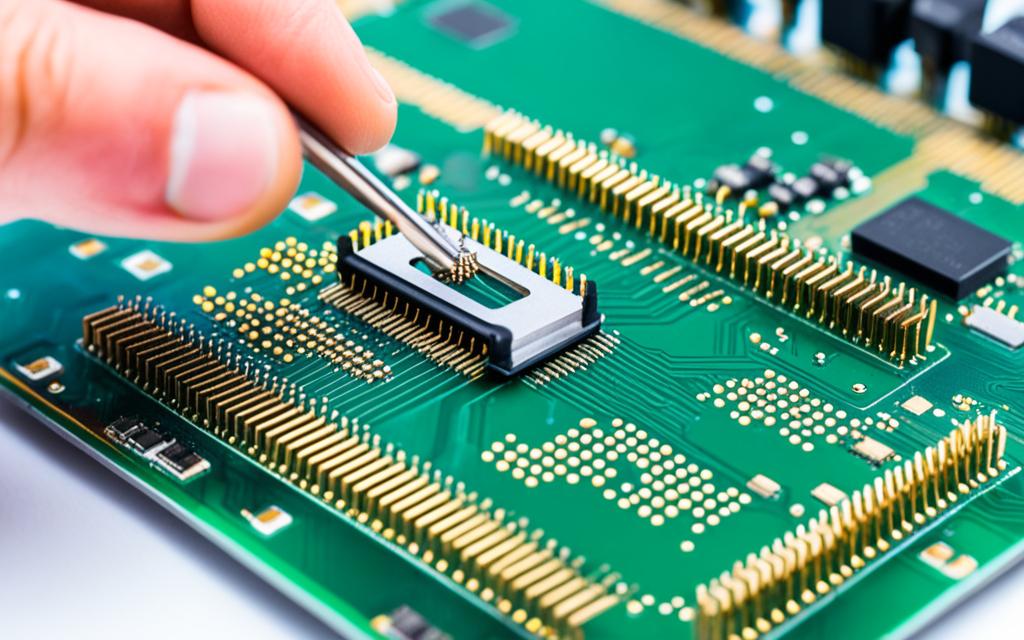Table of Contents
The central processing unit (CPU) is your computer’s heart. It executes instructions and processes data. Knowing how to diagnose CPU issues is key for good computer performance. Faulty CPU symptoms vary, including slow operation and failure to boot. It’s vital to identify and fix these issues quickly. They can greatly affect your computer use. In this guide, we’ll cover symptoms, how to diagnose them, and what to do next. With the right tools and knowledge, you can tackle CPU problems and fix your system efficiently12
Key Takeaways
- A faulty CPU can lead to computer performance problems such as unresponsiveness or overheating.
- Identifying a malfunctioning CPU early can prevent further damage to your system.
- Utilising diagnostic tools like CPU-Z can provide essential insight into your CPU’s condition.
- Stress testing your CPU under load can help reveal potential faults.
- External damage around the CPU socket may indicate severe overheating issues that require replacement.
- Listening for beep codes during boot-up can provide clues about CPU health.
- If issues persist, seeking professional assistance may be necessary to ensure a comprehensive diagnosis.
Understanding the Role of the CPU
The Central Processing Unit (CPU) is often called the computer’s brain. It executes instructions that make the computer work properly. These functions are key to a good computing experience.
The Brain of Your Computer
The CPU has many important jobs. It processes instructions, handles data, and manages commands. This is essential for the computer to run well and avoid being slow.
Common CPU Functions and Operations
- Instruction Execution: The CPU interprets and carries out software program instructions.
- Data Handling: It moves data between the memory and the computer’s parts.
- System Control: The CPU makes sure different parts work together well.
A problem with the CPU can greatly affect performance. Keeping the CPU updated and checked can prevent these issues. This helps your computer stay fast and reliable.
How a Faulting CPU Affects Your System
A damaged CPU can cause big problems, like overheating and system crashes. These issues can make the computer not work right because of harmful things like power surges and bad cooling. Computers older than five years are more likely to have these problems3. Overheating is especially bad. If the CPU gets too hot, it can break3. It’s important to keep the cooling systems working well.
https://www.youtube.com/watch?v=W4n4Wwmm7MA
Looking after your CPU well can help it last longer. By keeping an eye on things and fixing problems early, you can stop big failures. This keeps your work safe and your computer running smoothly.
| Potential Failure Symptoms | Technical Insight |
|---|---|
| No display on monitor | Could indicate CPU malfunction |
| Overheating | Triggers damage risks, monitored above 158 °F |
| System freezes during use | Commonly linked to CPU performance issues |
| Beeping sounds | Error codes indicate potential CPU errors |
Staying on top of cooling, maintenance, and spotting problems early is essential. Doing so helps your CPU work better for longer45.
Signs Your CPU May Be Failing
When you use your computer, some signs may hint at CPU problems. Spotting these early can prevent major issues and loss of data.
Symptoms of a Bad CPU
Common signs of a failing CPU include no display, overheating, and unexpected shutoffs. You might also see frequent blue screens or hear long beeps from the motherboard. These beeps could mean memory issues. It’s important to watch for these signs to find and fix the cause of instability.
Unexpected Behaviour: Crashes and Freezes
One major red flag is your computer freezing often. This could mean the problem lies within the CPU, not just the external devices. If your system crashes or shuts down suddenly without any reason, the CPU might be at fault. It’s crucial to address this immediately to prevent further damage.
The Importance of Error Codes and Beeping Sounds
Understanding error codes and beep patterns is vital. A short beep usually means the POST was successful. But a long beep can signal memory issues. Paying attention to these sounds helps diagnose computer problems early. For more help with faulty CPUs, check out this guide6.
How to Know if Your CPU is Bad
Figuring out if your CPU is healthy involves careful checks and analysis. Start by testing CPU performance with specific diagnostic software. There are many tools that help in evaluating your CPU’s condition.
Testing Your CPU with Diagnostic Software
Using diagnostic software is key to understanding your CPU’s health. It helps monitor crucial aspects like temperature and voltage. Tools such as CPU-Z, Intel Processor Diagnostic Tool, and AMD Ryzen Master offer valuable insights. They help identify any issues that need more exploration. It’s also good to visually check your CPU for any signs of damage, like burns, melted bits, or cracks7.
Running Diagnostic Tests: Recommended Tools
There’s a wide range of CPU test tools to evaluate your processor. For instance, if stress tests run smoothly for three hours, your CPU is probably fine5. Yet, if your computer freezes during games or web surfing, it may point to a problem between the CPU and RAM5. Also, be aware of the motherboard’s beep sounds or debug lights for quick insights into any issues.
Evaluating Test Results
Understanding diagnostic test outcomes is crucial. If your computer doesn’t show the boot screen, it might mean the CPU is not working right7. Signs like sudden shutdowns, freezing, and frequent blue screens signal possible CPU failures7. Record these issues carefully. Remember, poor airflow can make overheating worse, risking damage to your CPU5.
Investigating Other Potential Issues
When looking into possible CPU issues, remember other parts may be at fault too. Problems with the motherboard or power supply can greatly affect performance. These can show symptoms that seem like CPU failures.
Examining Your Motherboard and Power Supply
The motherboard is crucial, it links different parts of the computer. Look for damage like burnt areas or swollen capacitors. This might mean there are big problems with the motherboard. A bad power supply can make the computer act strangely. This includes unexpected shutdowns or sometimes the computer won’t start. These issues may hint at problems with the power unit7.
Inspecting RAM and Other Components
Checking RAM is critical when you’re having trouble with how the computer performs. If your RAM is not working right, your computer might freeze or crash. These problems could seem like they’re caused by the CPU. Try memory tests to make sure the RAM is okay. Also, make sure the RAM is put in correctly. This can fix many of the issues you’re facing5.
The Role of Overheating in CPU Failure
Keeping the CPU cool is very important. If it gets too hot, it can’t work right and might get damaged. Make sure your computer is cooling properly. Check for dust on fans and heatsinks regularly. If there’s not enough airflow, the CPU can overheat. Keeping an eye on this and doing regular checks can prevent major damage8.
Conclusion
Finding out what’s wrong with your CPU is key to keeping your computer running well. The warning signs, like sudden stops or freezing, tell us there might be serious CPU issues. These problems could really lower your computer’s performance93. Using the correct diagnostic tools can pinpoint what’s wrong. This helps you fix the issue and keeps your computer running well.
When self-help doesn’t solve the problem, it’s smart to get professional help. An expert can quickly find and fix the issue, making your computer work like new again. They can deal with overheating and outdated parts9.
It’s important to tackle CPU problems methodically. Keeping a close eye on your computer’s condition can prevent major damage. This careful attention helps your computer last longer and work better3. For more tips, check out this resource.
FAQ
What are the main symptoms of a faulty CPU?
A faulty CPU can show many symptoms. You might not see anything on your screen or hear beeping sounds from the motherboard. It might overheat, not respond well, show frequent blue screens, or even shut down unexpectedly. Spotting these signs early can prevent bigger problems with your computer’s performance.
How can I work out if my CPU is the problem?
Tools like CPU-Z, Intel Processor Diagnostic Tool, or AMD Ryzen Master can check your CPU. They look at temperature, voltage, and how well it works. These tools help find any issues with your CPU.
What should I do if the diagnostic tools find a problem?
If tools show there’s a problem, understanding the results is crucial. You might need to talk to a computer repair expert. They can do more tests and fix it, which helps your computer work well again.
Can other parts cause the same problems as a bad CPU?
Yes, parts like the motherboard, power supply, or RAM can also lead to similar issues. Checking these parts carefully helps find out what’s really wrong. It’s important to also look at the CPU closely.
How key is cooling for a CPU’s health?
Cooling stops the CPU from getting too hot, which can cause it to fail. Using good cooling methods and keeping your CPU well-maintained makes it more reliable and boosts its performance.
What should I do if fixing it myself doesn’t work?
If you can’t fix the issue on your own, getting help from a computer repair service is a good idea. They make sure the repair is done right. This improves your computer’s working and makes it last longer.
Source Links
- https://www.linkedin.com/advice/1/what-best-way-diagnose-repair-malfunctioning-cpu-ogf0e – What is the best way to diagnose and repair a malfunctioning CPU in a computer?
- https://computingaustralia.com.au/understanding-cpu-processor-failure-symptoms/ – Understanding CPU (Processor) Failure Symptoms
- https://www.jbit.tech/single-post/cpu-failures-causes-and-indications – CPU Failures: Causes and Indications
- https://www.linkedin.com/advice/0/what-steps-diagnose-faulty-cpu-skills-computer-repair-2tcfe – What are the steps to diagnose a faulty CPU?
- https://apexgamingpcs.com/blogs/apex-support/how-to-tell-if-cpu-is-bad – How to Tell if Your CPU is Bad With Fixes
- https://forums.tomshardware.com/threads/how-to-tell-if-your-cpu-or-motherboard-is-bad.386222/ – How to tell if your Cpu or motherboard is bad
- https://gadgetmates.com/how-to-know-if-your-cpu-is-dead-quick-easy-test – How To Know If Your CPU Is Dead? Quick & Easy Test – GadgetMates
- https://softwareg.com.au/blogs/computer-hardware/how-to-tell-if-a-cpu-is-bad – How To Tell If A CPU Is Bad
- https://www.pcguide.com/cpu/how-to/tell-is-failing-or-dead/ – How to tell if your CPU is failing or dead – 7 signs to look for








